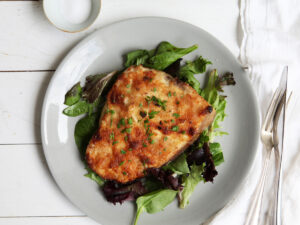Fire cider is a potent and flavorful herbal tonic traditionally used for its immune-boosting properties. Originating in the 1970s, it was popularized by herbalists for its health benefits, particularly as a remedy for colds, flu, and digestive issues. The recipe combines apple cider vinegar, garlic, ginger, horseradish, onion, and chili peppers, creating a zesty, spicy drink that’s been cherished for centuries for its natural healing properties.
This fire cider recipe is not just a drink; it’s a remedy. It has become a favorite among those looking to support their immune system naturally and give their body a boost. The flavor is tangy, spicy, and a little sweet, with a delightful heat from the peppers that makes it an excellent tonic to sip on or use in cooking.
Ingredients
Here’s what you’ll need to make a traditional fire cider recipe:
- 1 quart apple cider vinegar (preferably organic, raw, and unfiltered)
- 1/4 cup grated ginger root
- 1/4 cup grated horseradish root (or substitute with a little extra ginger)
- 1 onion, peeled and chopped
- 10 cloves garlic, peeled and smashed
- 1-2 hot chili peppers, chopped (such as jalapenos or habaneros)
- 2 tablespoons mustard seeds
- 1 tablespoon black peppercorns
- 1/4 cup raw honey (or maple syrup for vegan version)
- Optional: A pinch of turmeric or cayenne pepper for added heat and anti-inflammatory properties
Possible Substitutions:



- Vegan Option: Substitute honey with maple syrup or agave nectar.
- Gluten-Free: Ensure the vinegar and all ingredients are gluten-free (most are naturally, but always check labels).
- Spice Level: Adjust the heat by varying the amount or type of chili peppers. Use bell peppers for a milder version.
Step-by-Step Cooking Instructions
-
Prepare the Ingredients:
Begin by finely chopping or grating the ginger, horseradish, onion, garlic, and chili peppers. Place all of these ingredients into a clean, sterilized quart-sized glass jar. -
Add the Spices:
Add the mustard seeds, peppercorns, and any optional spices like turmeric or cayenne pepper. These will add extra flavor and heat to the cider. -
Fill the Jar:
Pour the apple cider vinegar into the jar, covering the ingredients completely. Make sure there’s at least an inch of space at the top to allow for expansion. -
Seal and Store:
Seal the jar tightly and shake it gently to mix the ingredients. Store the jar in a cool, dark place for at least two weeks. Shake the jar daily to help extract the flavors. -
Strain and Sweeten:
After two weeks, strain the vinegar mixture into a clean bottle, discarding the solids. Add honey to taste, starting with about 2 tablespoons, and adjust depending on your preferred sweetness level. -
Enjoy:
Your homemade fire cider is now ready! You can take it straight as a tonic (1-2 tablespoons per day), add it to hot water for a soothing drink, or use it in salad dressings, marinades, or soups.
Common Mistakes to Avoid:
- Not Shaking Daily: Be sure to shake the jar every day. This helps the flavors infuse into the vinegar.
- Using Low-Quality Vinegar: The quality of the vinegar is crucial for flavor and health benefits. Always use organic, raw apple cider vinegar.
- Overlooking the Straining Step: Strain the mixture thoroughly to remove all the solids, leaving only the flavorful vinegar behind.
Pro Tips and Cooking Techniques
- Fresh Ingredients: Use fresh, organic ingredients whenever possible to maximize flavor and health benefits.
- Let It Sit Longer: For a more intense flavor, you can let the fire cider sit for up to four weeks.
- Use a Cheesecloth or Nut Milk Bag: For easier straining, consider using a cheesecloth or nut milk bag to remove solids without leaving bits behind.
Variations and Customizations
- Vegan Version: Use maple syrup or agave nectar instead of honey to make a fully plant-based fire cider.
- Extra Heat: For those who love spicy flavors, add more chili peppers or experiment with different varieties, such as ghost peppers.
- Herbal Additions: Add herbs like rosemary or thyme for extra aromatic flavors and medicinal properties.
Serving Suggestions
- As a Tonic: Take 1-2 tablespoons daily to boost immunity and digestion. You can dilute it with a little water or honey to ease the intensity.
- In Cooking: Fire cider can be used in marinades for meats, drizzled on roasted vegetables, or mixed into salad dressings for an extra kick.
- Hot Drink: Mix fire cider with hot water, honey, and lemon for a soothing, warming drink that’s perfect during cold weather or when you feel a cold coming on.
Nutritional Information
While fire cider is not typically consumed in large quantities, here’s an approximate breakdown of the nutritional content per 1 tablespoon (without honey):
- Calories: 5-10
- Carbohydrates: 1g
- Protein: 0g
- Fat: 0g
- Sodium: 10-15mg
- Vitamins and Minerals: Small amounts of vitamins A, C, and minerals like potassium and magnesium, depending on the ingredients.
Frequently Asked Questions (FAQs)
1. How long does fire cider last?
Fire cider can last for several months when stored in a cool, dark place, ideally up to 6 months.
2. Can I use a different vinegar?
Apple cider vinegar is the best option, but you could substitute it with white vinegar in a pinch. However, it may affect the flavor and health benefits.
3. What’s the best way to take fire cider?
You can drink it straight, mix it with water, or use it in various dishes for a tangy kick.
4. How can I make fire cider less spicy?
Reduce the number of chili peppers or omit them entirely for a milder version.
Closing Thoughts
Fire cider is not only a flavorful and spicy tonic but also an excellent natural remedy with deep historical roots. It’s a wonderful way to support your health naturally and add bold flavors to your meals. Whether you’re looking to boost your immune system, improve digestion, or simply enjoy a fiery, tangy drink, this recipe is sure to satisfy.



